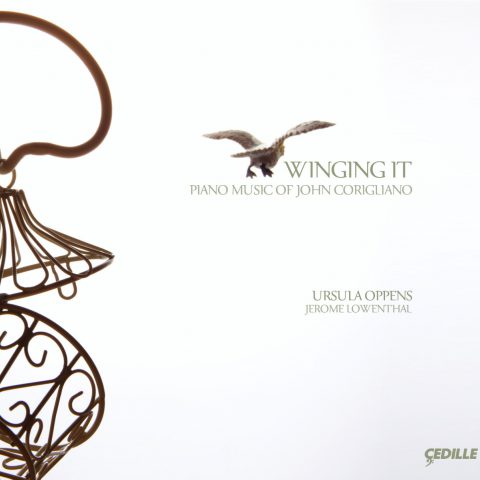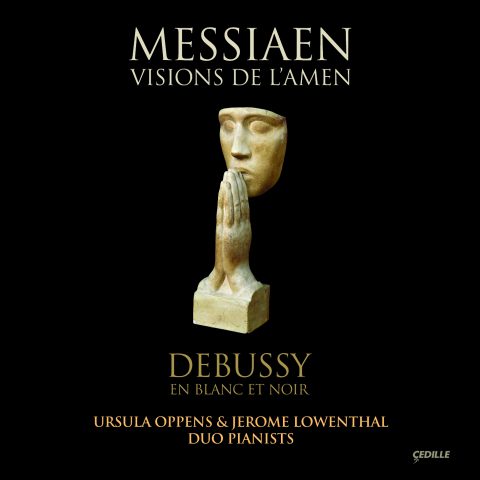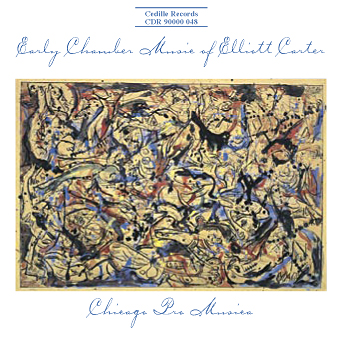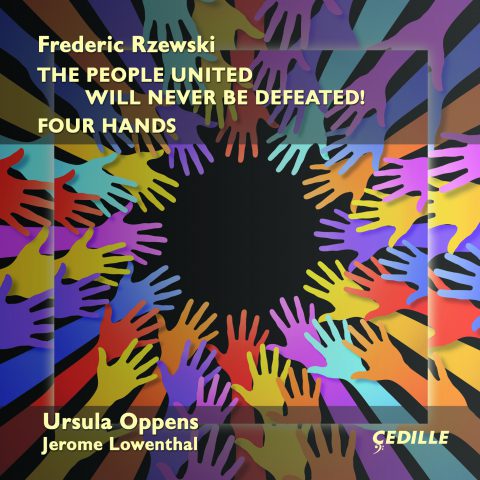| Subtotal | $18.00 |
|---|---|
| Tax | $1.85 |
| Total | $19.85 |
Store
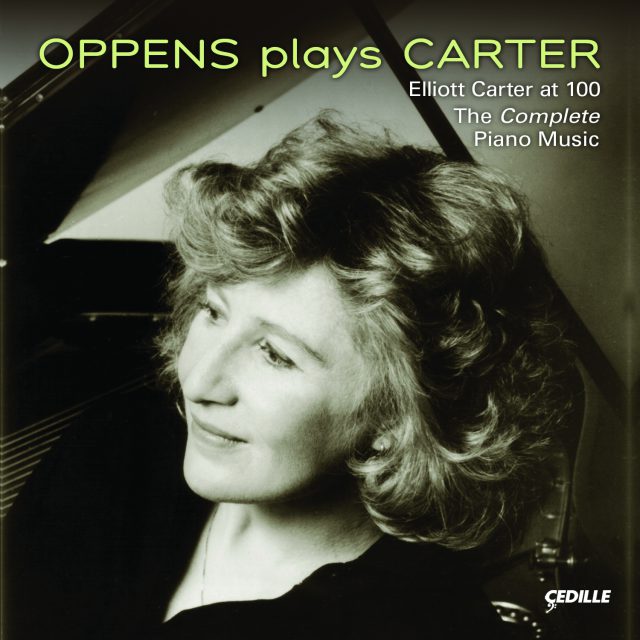
Ursula is very grateful to Brandon Fradd and the Musical Explorations Society, whose sponsorship made this recording possible.
Cedille Records celebrates composer Elliott Carter’s 100th birthday (December 11) with Oppens Plays Carter, the only fully-complete CD survey of Carter’s solo piano works, including two world premieres, performed by one of his leading interpreters – American pianist Ursula Oppens.
The disc brings together the composer whom Aaron Copland called “one of America’s most distinguished creative artists in any field” with a pianist “known particularly for the intelligence, technical skill and warmth she brings to… contemporary music.” (Grove Music)
The disc features Carter’s pivotal Piano Sonata (1945-46), the breakthrough work in which Carter found his voice and projected the scope of his talent, and his transcendental Night Fantasies (1980), written for a group of four pianists including Ms. Oppens, who gave the premiere. Seven shorter pieces written between 1994 and 2007 complete the disc, which concludes with the world premiere recording of Carter’s virtuosic Catenaires (2006), a harmonically compelling, fiendishly difficult, toccata-like succession of rapid-fire 16th notes.
Oppens Plays Carter is the perfect tribute to the “Dean” of American composers by the pianist most closely associated with his music.
Preview Excerpts
ELLIOTT CARTER (1908-2012)
Two Diversions
Piano Sonata
Two Thoughts About the Piano
Artists
Program Notes
Download Album BookletCarter at the Keyboard
Notes by Bayan Northcott
Thinking back to his Upper West Side New York boyhood just after the First World War, Elliott Carter has recalled that, “Despite the fact that neither of my parents was particularly musical, they did have a player-piano and decided, when I was in the third or fourth grade, that I should take piano lessons. As a result of this I began to have to learn Chopin and practise scales and the rest of it which I just hated for a very long time.” Nevertheless, he persisted doggedly enough to be able to perform Scriabin and Schoenberg in concert during his student years, and the few precious seconds of documentary footage of the mature Carter trying over passages in progress at his workroom piano in more recent decades have suggested he retains a considerable technique.
Any idea of pursuing an executant’s career, however, was stymied early by “poor performing nerves”; and one could hardly suggest that the piano has proved as indispensable to Carter’s musical thought as it was to such composers as Beethoven, Chopin, or Debussy; nor, again, has he consistently used it as a “black and white” medium for musical studies after the manner of Schoenberg, or of Stockhausen who described the succession of solo piano pieces scattered through his output as his “line-drawings.” Of course, Carter has composed an impressive succession of concertante works — the Double Concerto for piano and harpsichord (1961), the Piano Concerto (1966), Dialogues for piano and large ensemble (2003), Interventions for piano and orchestra (2007) — and he has frequently used the instrument in his orchestral and chamber works. Yet, until his 86th year, his published catalogue for solo piano comprised just two scores: the Sonata for Piano (1946) and Night Fantasies (1980)
It would, however, be no exaggeration to describe these as the turning points, the hinges between the three periods in which we increasing perceive Carter’s development. In its harmonic ambience and thematic working, the Piano Sonata still retains echoes of the neo-classical
and American populist idioms from which the young Carter strove to extract his own voice in the late 1930s and early ’40s; but it is already well advanced upon his endeavour to generate the entire formal and expressive fabric of his works from the sounds and playing techniques of the very instruments for which he was writing — an endeavour that was to culminate
in the vastly elaborate structures of his middle years. Night Fantasies epitomises such sonic-structural thinking
in particularly concentrated form, but it also puts in place the final technical elements making for the extraordinary integration and consistency of Carter’s musical language since around 1980 — an integration that has enabled him to compose with an enhanced spontaneity and fancifulness, not least in the half dozen shorter piano pieces that make up the rest of this disc.
Maybe the composer Carter most resembles in this progress is Brahms, who preoccupied himself with sonata forms early on, piano variations in mid-career (Night Fantasies could be construed as a kind of variation sequence), and collections of concentrated miniatures late on. But, aside from a comparable concern for compositional facture and coherent detail, there is little in Carter’s music to remind us overtly of Brahms. Indeed, a listener coming to his Piano Sonata and Night Fantasies for the first time might find it difficult to believe they were the work of the same composer, so radical was his evolution between them — or that the hand that wrote the grand pandiatonic apostrophes that launch the Sonata was the same that dashed off the skittish chromatics of Matribute sixty two years later. Certain attitudes and predilections have nonetheless remained pretty constant in Carter’s approach to the piano over the decades
Like the great 19th and early 20th century composer-performers, Carter has always regarded the keyboard as a challenge to virtuosity: how much one pair of human hands, moving with maximum agility, strength, and variety of touch, can draw from the percussive and resonant sonorities of the seven-and–a-bit octaves of the modern concert grand (plus foot control of its three pedals). All of his solo piano writing is technically demanding; even the Two Diversions intended for young players are tricky for all but the most proficient amateurs. This love of virtuosity has recurrently expressed itself in contrasts of the most powerfully amassed chordal sonorities with glittering flights of toccata figuration. Behind such textural juxtapositions, one senses a more abstract background process, as though Carter conceives the piano’s range as space to be mapped out in contrasting areas, heights and depths — with the actual piece comprising, as it were, a journey across that map. Such an apprehension of different regions being traversed is perhaps especially immanent in Night Fantasies, but one suspects comparable conceptions, whether elaborate or summary, lie equally behind the broad spans of the Piano Sonata or a late, ostensibly linear miniature such as Caténaries. It is the way that Carter contrives, sooner or later, to visit every area of the notional map of the piece in progress, so that the whole keyboard is ultimately “covered,” that lends his endings their special sense of completion
90+ (1994)
When Carter’s vast and innovatory String Quartet No 1 (1950–51) received its Italian premiere in Rome in 1953, among the first to offer congratulations was the distinguished Italian composer Goffredo Petrassi. During Carter’s several subsequent residencies over the years in the American Academy in Rome, their acquaintance grew into a warm friendship, and it was to celebrate Petrassi’s 90th birthday that Carter wrote this first of his late miniatures — the piece being premiered by Guiseppe Scotese on June 11, 1994, at the Pontino Festival dedicated to Petrassi’s birthday. In his program note, Carter writes: “90+ for piano is built around ninety short, accented notes played in a slow regular beat. Against these, the context changes character continually.” However, this slow tactus is out of sync with the mostly 4/4 bar structure of the score, so that the regular beats seem to play hide and seek with their surrounding figures and chords. Towards the centre of the piece, the texture thins to mere sprinkling of staccato notes, as though most of the connecting texture had been rubbed out. Events then accumulate to a brief climax, breaking off for the emphatic 90th beat. However, in a charming coda, the beats continue at a quickening pace, as though Carter were wishing Petrassi to live on into his 120s…
Retrouvailles (2000)
Of all Carter’s younger contemporaries, it is probably with Pierre Boulez that he has most intensively compared notes over compositional concepts and details of technique. Boulez has written admiringly of Carter’s handling of time and “the gripping complexity of his poetic universe,” while Carter has marked no less than four Boulez birthdays with celebratory pieces. In 2000, he was one of twelve composers — including Berio, Birtwistle, Kurtag, Lindberg, and Rihm — commissioned by the Southbank Board in London to compose a short piece for Boulez’s 75th birthday. These were duly launched in Boulez’s presence at a concert on June 26, 2000, by the young British pianist Rolf Hind, and issued on an instant CD to ticket holders after the concert, courtesy of BBC Radio 3. The title means things retrieved, and the piece duly reworks the motto on the letters of Boulez’s name that Carter had already used in his duo for flute and clarinet Esprit Rude/ Esprit Doux (1985) composed for Boulez’s 60th birthday and the trio Esprit Rude/ Esprit Doux, II (1995) for his 70th. Variants of this stride through Retrouvailles surrounded by a volatile conspectus of Carterian piano gestures and textures, so that the piece sounds far more substantial than the mere minute-and-a-half it takes to play
Night Fantasies (1980)
Doubtless it was with the idea of tempting Carter back to large-scale solo piano composition that the late Paul Jacobs invited three of his most distinguished fellow pianists, Ursula Oppens, Charles Rosen, and Gilbert Kalish, to join him in commissioning the present work, with funds raised by The American Music Center of New York. Partly inspired by the contrasting personalities of the four pianists, all well-known to him, Carter turned to the 19th century genre of character-piece exemplified in such collections as Schumann’s Kreisleriana. Yet, far from comprising a picturesque set of miniatures, the continuous resulting 20-minute score emerged as among the most demanding to perform and to comprehend in his entire output; a work, indeed, which Charles Rosen has hailed as the most significant new contribution to the repertoire of transcendental pianism since Ravel’s Gaspard de la nuit. In his preface, Carter writes:
Night Fantasies is a piano piece of continually changing moods, suggesting the fleeting thoughts and feelings that pass through the mind during a period of wakefulness at night. The quiet nocturnal evocation with which it begins and [to which it] returns occasionally, is suddenly broken by a flighty series of short phrases that emerge and disappear. This episode is followed by many others of contrasting characters and lengths that sometimes break in abruptly and, at other times, develop smoothly out of what has gone before. The work culminates in a loud, obsessive repetition of an emphatic chord that, as it dies, brings the work to its conclusion.
As this suggests, Night Fantasies comes over very much as the darkly volatile opposite to the Piano Sonata’s ordered brightness: erupting out of a tensely measured stillness in an often turbid flux of tortuous lines and angry gestures, periodically lit by tingling meteor showers of figuration and with a recitativo collerico of nagging tritones (played mainly by the thumbs!) at its centre. Although certain textures recur, there are no themes in the traditional sense; Carter is concerned rather with the experience of changefulness itself. The culminating chord he mentions comprises a grinding dissonance of just four widely spaced pitches that continually interrupt the flow like an insomniac’s Idée fixe — until, unexpectedly, the music quietly drops off to sleep. In seeking to hold the work’s various moods and textures together, Carter laid out a comprehensive harmonic “background” of 88 all-interval chords, while backing his rhythms by two distinct pulses— like two clocks ticking at slightly different rates — which only coincide twice: near the beginning and towards the end. Neither of these procedures is easily apprehensible by the listener, nor are they intended to be. Rather, the referential chords helped the composer to monitor the consistency of his harmony, just as the pulses helped him to define the rhythmic independence of the two hands. As always in Carter, technical innovations are only a means to an expressive or poetic end — though he was to continue exploring the possibilities of such comprehensive harmonic and double-pulse schemes in many of his subsequent scores of the 1980s and ’90s. Of the four commissioning pianists, it fell to Ursula Oppens to give the world premiere at the Bath Festival (then directed by Carter’s long-standing supporter Sir William Glock) on June 2, 1980, when the performance was prefaced with a short spoken introduction by the present writer.
Two Diversions (1999)
These two short studies are rather exceptional in Carter’s output in being addressed not to the most brilliant virtuosi, but to more modest techniques, particularly of young players. One of ten composers invited to contribute to the Carnegie Hall Millennium Piano Book, he here reverts somewhat to the more clear-cut constructivist techniques of the late 1940s when he was building on the breakthrough discoveries of the Piano Sonata, and adapting to his own purposes certain cross-rhythmic ideas of his colleague and friend, Conlon Nancarrow. The Two Diversions, he writes, exploit “a growing contrast between simultaneous musical ideas.” Diversion 1 “presents a line of paired notes, musical intervals, that maintain a single speed throughout, while the other very changeable material uses many different speeds and characters.” Diversion 2 “contrasts two musical lines, one of which, on the whole, grows slower and slower, while the other grows faster and faster” — an idea, one might add, that Carter had already exploited dramatically long before in his Double Concerto (1961). Ursula Oppens and four students presented the entire Millennium Piano Book in Carnegie Hall’s Weill Recital Hall on March 2, 2000, with Kirill Gerstein from the Manhattan School of Music premiering the Carter.
Matribute (2007)
Carter’s titles in more recent years have ranged from laconically abstract — Changes, Soundings, Interventions — to poetic — Scrivo in Vento, In the Distances of Sleep — to teasingly oblique — such as Au Quai, which, in addition to punning on the initials of its dedicatee Oliver Knussen, depends, for its full meaning, upon knowledge of an anecdote told by Schoenberg! Matribute, however — requested by James Levine as a birthday offering to his mother Helen Levine — is exactly what it says: a tribute to Ma. Technically, Carter could have called it Diversion 3, since it comprises a comparable study in contrary rates of unfolding. It begins with fragmentary fast figuration in the right hand against a deep sustained line in the left. On its periodic resumptions, the slow line tends to quicken and rise in pitch until it fuses with the fast figuration in a coruscating upward flurry, terminated by a single staccato C natural. Maestro Levine played the first performance himself in Lucerne on August 27, 2007.
Piano Sonata (1945–46)
Shortly before going to Harvard in 1926, Carter has recalled, “I had already tried writing a very ‘advanced’ and complicated piano sonata… which I showed to Charles Ives at the time. He encouraged me to go on and become a composer, which I very much wanted to do, though for a long time I didn’t admit this to my parents.” However, all traces of that early effort had disappeared by the time Carter embarked upon the present work, while his review of the belated, but rapturously received premiere of Ives’s Concord Sonata in 1939 showed that he now felt the music of his mentor was often confused and fell short of its aspirations. Meanwhile, he was well aware of his older friend Copland’s formidable recent Piano Sonata (1943) and that his younger contemporary, Samuel Barber, was about to embark on an ambitious sonata for Horowitz. On the face of it, the 23-minute two-movement structure Carter completed in 1946, with the support of a Guggenheim Award, was milder in idiom than either the austere, hard-bitten Copland or the chromatically rampaging Barber, let alone the transcendentally dissonant Ives. Yet in its underlying concept and the clear-headedness with which it was realized, it was arguably the most radical of all.
For while the opening movement can be heard more or less as a traditional sonata form and the second comprises a fast fugue flanked by a more stately introduction and epilogue, they are not really generated by the thematic material that appears in them; the themes serve rather as section-markers on the surface of a musical flow built out of more fundamental harmonic and rhythmic elements. At the outset, Carter slowly alternates deep pedal notes on B and B-flat, catching their higher resonances in chords of fifths and thirds which, variously superimposed and “colored” by accidentals are to infuse the harmony of the entire work. Soon the fingers take up these harmonies, breaking them into irregular groupings of a regular fast pulse to create dazzling flights of figuration — a kind of modern Scarlatti sound. Only subsequently does the music settle on a more moderately flowing modal “second subject”; and it is the cross-cutting of these three types of music that drives the first movement as much as its apparent sonata form — until it finally comes to provisional rest on B-flat.
Although technically in a new key, the sarabande-like opening of the second movement sounds more like a variant of the beginning of the first than a fresh departure. After an ensuing, more rocking episode, Carter resorts, as in certain transitional junctures in the first movement, to harmonics — sounds evoked by pressing piano keys silently and activating their humming resonances by staccato lower notes. Out of these, the theme of the fugue gradually takes shape. But the fugue itself, again on a fast regular pulse, is as much concerned with rhythmic variation as with the theme — which is progressively shortened on its reappearances. Following the grandiose upward flourishes with which the fugue culminates, the sarabande idea and harmonics return, the movement slowly unwinding to a luminous stasis on B.
First heard in a New York broadcast performance by Webster Aitken on February 16, 1947, the Sonata takes further certain devices of Carter’s earlier works and retains, in its polydiatonic ambience, resonances of Copland and even (then) recent Stravinsky. Yet it only passingly alludes to American folkism, while its big-boned rhetoric is already a world away from the clipped niceties of neo-classicism. And if no subsequent Carter work sounds quite like it either, it remains the work in which he found his true “way” and first revealed his scope.
Intermittences (2005) (Two Thoughts about the Piano, Part 1)
This concentrated single-movement piece was co-commissioned by the Carnegie Hall Corporation and the Gilmore International Keyboard Festival for Peter Serkin, who gave the premiere in Miller Auditorium, Kalamazoo, Michigan on May 3, 2006. In its frequent use of dense and gritty chords, this is, among Carter’s more recent pieces, the most reminiscent in sound to Night Fantasies, while its reactivation of harmonics— notably to alter the timbre of recurrent pitches, as at the very end — even harks back to the Sonata. Yet its brusqueness of unfolding, forever punctuated by jump-cuts of texture and unpredictable pauses lends it an entirely different character. As Carter wrote: “The many meanings silence can express in a musical discourse challenged me to use some of them in Intermittences. The title was suggested by ‘Intermittences du coeur’, one of the chapters in Proust’s novel. It is a short work which uses many different piano sounds to convey its expressive meanings.” Although first composed as complete in itself, and still performable as such, Carter has come to regard Intermittences as part of a diptych entitled Two Thoughts About the Piano, completed by…
Caténaires (2006) (Two Thoughts About the Piano, Part 2)
Considering his previous output and known predilections, Caténaires is, on the face of it, the unlikeliest of all Carter’s piano works. “When Pierre-Laurent Aimard, who performs so eloquently, asked me to write a piece for him,” Carter confesses, “I became obsessed with the idea of a fast one-line piece with no chords. It became a continuous chain of notes using different spacings, accents and colourings, to produce a wide variety of expression.” The piece Aimard duly found himself launching at Zankel Hall, New York, on December 11, 2006, not only comprises an unbroken four-minute succession of 16th notes permutating and arpeggiating all over the keyboard at a terrifying speed, but requires all manner of irregular changes of touch and dynamics, suggesting, in its later stages, a succession of “ghost” cross-pulsations. No wonder Carter has come to feel this incessant piece belongs with Intermittences: together they create a perfect balance of opposites. Yet there are precedents in the toccata-writing that intermittently darts through all of Carter’s previous piano pieces — and, perhaps, more remotely, in the strange one-line moto perpetuo Chopin composed as the finale to his Piano Sonata in B-flat minor. If so, it is a pleasing irony from a composer who set out 90 years ago just hating to practise Chopin.
ABOUT URSULA OPPENS
Ursula Oppens is one of the very first artists to program traditional and contemporary works in equal measure. An enduring commitment to integrating new music into regular concert life has led Ms. Oppens to commission and premiere countless compositions. In addition to her long and productive association with Elliott Carter, she has premiered works by such leading composers as Luciano Berio, William Bolcom, John Harbison, Julius Hemphill, Tania Leon, Harold Meltzer, György Ligeti, Witold Lutoslawski, Conlon Nancarrow, Tobias Picker, Frederic Rzewski, Joan Tower, Amy Williams, Christian Wolff, Amnon Wolman, and Charles Wuorinen.
Ms. Oppens has performed with virtually all of the world’s major orchestras. She has been heard with the New York Philharmonic, Boston Symphony Orchestra, Los Angeles Philharmonic, American Composers Orchestra, and the orchestras of Chicago, Cleveland, San Francisco, and Milwaukee. Abroad, she has appeared with such orchestras as the Berlin Symphony, Orchestre de la Suisse Romande, Deutsche Symphonie, and the BBC Scottish and London Philharmonic Orchestras. She has also performed as the piano soloist for the Mark Morris Company’s Mozart Dances. An avid chamber musician, Ms. Oppens has performed with the Arditti, Juilliard, Pacifica, and Rosetti quartets, among others. She is a prolific recording artist, many of whose discs, including her recording of the landmark Frederic Rzewski work, “The People United Will Never Be Defeated,” are phonographic classics.
Ms. Oppens launched Mr. Carter’s year-long 100th birthday celebration by performing a solo recital of his works in January 2007 at Symphony Space in New York City. In fall 2008, Ms. Oppens takes up her new post as Distinguished Professor of Music at Brooklyn College and the CUNY Graduate Center in New York City. From 1994 through the end of the 2007–08 academic year she served as John Evans Distinguished Professor of Music at Northwestern University in Evanston, Illinois.
ABOUT ELLIOTT CARTER (1908-2012)
Twice winner of the Pulitzer Prize, first composer to receive the United States National Medal of Arts, one of the few composers ever awarded Germany’s Ernst von Siemens Music Prize, and in 1988 made “Commandeur dans l’Ordre des Arts et des Lettres” by the Government of France, Elliott Carter is internationally recognized as one of the leading American voices of the classical music tradition. He recently received the Prince Pierre Foundation Music Award, bestowed by the Principality of Monaco, and is one of a handful of living composers elected to the Classical Music Hall of Fame.
First encouraged toward a musical career by his friend and mentor Charles Ives, Carter was recognized by the Pulitzer Prize Committee for the first time in 1960 for his groundbreaking String Quartet No. 2. Stravinsky hailed Carter’s Double Concerto for harpsichord, piano, and two chamber orchestras (1961) and Piano Concerto (1967) as “masterpieces.” While he spent much of the 1960s composing just two works, the Piano Concerto and Concerto for Orchestra (1969), the breakthroughs he achieved in those pieces led to an artistic resurgence that gathered momentum in the decades that followed. Indeed, one of the extraordinary features of Carter’s career is his unabated productivity and creative vitality as he reaches the zenith of his tenth decade.
This astonishing late-career creative burst has resulted in a plethora of new works. The first few weeks of 2004 brought a pair of acclaimed new scores: Micomicon, a witty concert-opener for the Boston Symphony Orchestra, and the incisive Dialogues for piano and large ensemble, commissioned by the London Sinfonietta. France enjoyed the world premiere of Réflexions at Cité de la Musique in February 2005, celebrating the work with multiple ovations. In October 2005, the Boston Symphony Orchestra brought to life Carter’s Three Illusions for Orchestra, a piece The Boston Globe called “surprising, inevitable, and vividly orchestrated.” In the same month, Daniel Barenboim assumed the roles of conductor and pianist in the world premiere of Soundings with the Chicago Symphony Orchestra
Carter continues to show his mastery in smaller forms as well. Along with a large number of brief solo and chamber works, his later years have brought major essays such as the Quintet for piano and winds (1991), String Quartet No.5 (1995) composed for the Arditti Quartet, and Asko Concerto (2000) for Holland’s ASKO Ensemble. Recent premieres of chamber works include the playfully humorous Mosaic, by the Nash Ensemble in 2005, as well as three premieres in 2006: Intermittences, a piano solo co-commissioned by the Carnegie Hall Corporation and The Gilmore International Keyboard Festival and performed by Peter Serkin; In the Distances of Sleep, with Michelle DeYoung and the MET Chamber Ensemble under James Levine; and Caténaires, a solo piano piece performed by Pierre-Laurent Aimard. Most recently, Carter’s Horn Concerto, written for James Sommerville, was premiered on November 15, 2007 with the Boston Symphony Orchestra under James Levine.
December 11, 2008, will mark Carter’s 100th birthday.
Album Details
Total Time: 70:53
Producer & Engineer: Judith Sherman
Engineering & Editing Assistant: Jeanne Velonis
Graphic Design: Melanie Germond
Cover Photo: Christian Steiner
Photo of Elliott Carter and Ursula Oppens (p. 3 & traycard): Malcolm Addey
Recorded: February 4-8, 2008, at the American Academy of Arts and Letters, NYC
Steinway Piano
Publishers:
90+, Retrouvailles, Two Diversions for Piano, Two Thoughts about Piano (Catenaires and Intermittences): Hendon Music, Inc.
Night Fantasies: Associated Music Publishers
Matribute: Boosey & Hawkes, Inc.
Piano Sonata: Theodore Pressser Company
© 2008 Cedille Records/Cedille Chicago
CDR 90000 108
